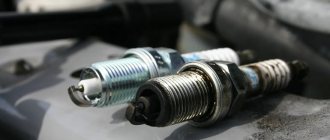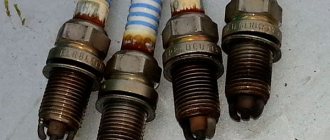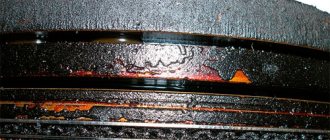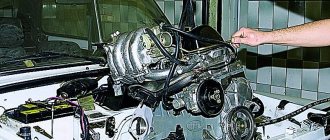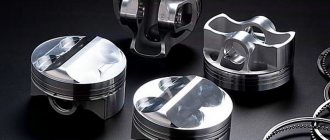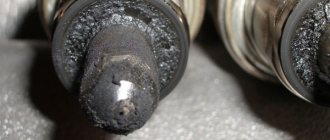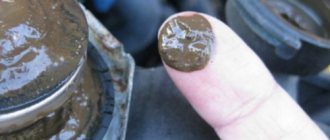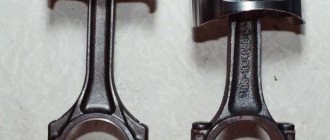Soot on valves is a very harmful phenomenon that reduces engine power, makes its operation unstable, and in very “neglected” cases can even lead to complete failure of the gas distribution system. Engines with direct injection are the most susceptible to carbon deposits on valves. This is due to their design. However, engines with distributed injection are also susceptible to it, although to a much lesser extent.
Currently, carbon deposits can be removed from valves using two methods - with and without dismantling them. The first method is used when the amount of carbon deposits becomes critical, which leads to a decrease in engine power characteristics. Typically, this procedure is performed in a car service center, since it is quite complex and requires special equipment to perform it. The second method (without dismantling) involves the use of special chemicals that can be used to get rid of carbon deposits. However, such compositions are effective only when the amount of soot is small; they are unlikely to be suitable for complex “neglected” cases.
Principle of operation
In order to perform a procedure such as cleaning a part, you need to understand how it works. In the internal combustion chamber, the gases expand and energy is transferred to the piston. The connecting rods then drive the crankshaft. This block is continuously exposed to temperature, mechanical and other extraneous loads. Experiencing the force of gas pressure, the piston becomes very hot due to contact with substances that are formed from the combustion of fuel.
Due to the increased load on the piston during operation, black carbon deposits gradually form on it. This also happens due to some kind of motor failure. Often such malfunctions can become a factor affecting the disruption of the combustion process of the fuel mixture inside the cylinders.
Valve functions
Before moving on to the question of why carbon deposits form on valves and how to get rid of it, it is necessary to briefly dwell on the functions that the timing mechanism (TIM) valves perform directly. This will help in understanding the process in the future. So, the main function of the valves is to close the combustion chamber at a certain point in time so that the ignited air-fuel mixture does not escape from it. It is this that presses on the piston, which, in turn, spins the crankshaft, which ensures normal engine operation.
There are two types of timing valves - intake and exhaust. Air or an air-fuel mixture enters the engine through the intake valves (this depends on what type of injection is used in the engine, more on that a little later). Exhaust valves are necessary to remove exhaust gases that are formed as a result of combustion in the cylinder chamber.
What is carbon deposits on pistons?
Looking inside the power plant, we will definitely see that many parts are covered with deposits of various types. Experienced drivers divide them into sludge, carbon deposits and varnish formations. One of the reasons for the formation of deposits is the breakdown of engine oil in the engine. It oxidizes and decomposes over time, so breakdown products can settle on the elements, forming a deposit. Therefore, every driver should know how to clean the piston from carbon deposits.
How to avoid carbon deposits
To avoid the formation of plaque, soot, and coking of moving and stationary parts of an internal combustion engine, the following preventive measures should be carried out:
- Fill with high-quality motor oil.
- The ignition, the valves, and everything that is needed for the correct operation of the internal combustion engine must be correctly adjusted. The more completely the supplied fuel burns, the less carbon deposits will be on the pistons, valves and combustion chambers. There should be no over-suction or overflow. Therefore, the condition of pistons, cylinders, connecting rods, injectors, spark plugs, valves, valve seals will increase the period of formation of soot and coke.
- Change oil and filters in a timely manner. If you fill in the cheapest oil, then at least you need to change it more often (for example, after 7 thousand kilometers). The cleaner the engine oil, the correspondingly cleaner the parts will be (no soot and coke). When using high-quality expensive motor oils, the replacement schedule is 15 thousand kilometers.
- Pass maintenance in a timely manner.
- Fuel with quality fuel. The fuel liquid contains resins, their content must comply with the standards. Therefore, it is better to refuel your cars at large gas stations.
Also, if desired, before updating the engine oil according to schedule, you can do a “soft” cleaning to prevent the formation of layers of soot and coke.
Causes of soot
The most common cause of soot is incomplete combustion of fuel or a high percentage of various impurities and additives in the fuel. Once fuel comes into contact with a heated piston, valves or cylinder walls, harmful additives begin to accumulate, and over time a whole layer of deposits forms.
One common reason is infrequent oil changes. When the driver does not take care of regular inspection of this system, the engine gradually begins to coke. Therefore, experienced car mechanics recommend changing the oil after driving 15-20 thousand km. Other factors that affect piston fouling include:
- failed injectors;
- old spark plugs;
- faulty seals;
- wear of piston rings.
Sludge most often forms on the side surfaces of pistons and cylinder walls. Experts believe that carbon deposits appearing at the top of the piston will contribute to increased wear on the cylinder walls. Deposits can become lodged in the gap between the groove and the ring on the piston. This leads to significant engine wear. Therefore, it is better to fix the problem as quickly as possible.
When to remove carbon deposits - the first symptoms
First of all, let's figure out how to determine that the engine needs to be cleaned from carbon deposits that have formed inside the cylinders and on its other parts. Fortunately, the problem manifests itself with the following symptoms:
- an unheated engine does not start well;
- after starting, strong smoke comes out of the exhaust pipe, the engine stalls for some time;
- exhaust gases have a specific burning smell;
- the dynamics of the car decreases, the engine “pulls” poorly;
- excessive fuel consumption appears;
- When the ignition is turned off, the fuel in the cylinders continues to ignite for some time, and strong vibrations occur. This phenomenon is called glow ignition, since the ignition of the combustible mixture occurs from hot carbon deposits, and not from a spark;
- The engine gets very hot.
If these signs appear, do not delay cleaning the engine, as the presence of carbon deposits can lead to more unpleasant consequences, such as burnout of valves, failure of the connecting rod and piston group. To prevent carbon deposits from forming on engine parts for as long as possible, use high-quality synthetic or semi-synthetic oils and be sure to change them on time.
Cleaning pistons without disassembling the engine
According to experienced specialists with many years of practice, it is imperative to use manual mechanical cleaning in order to efficiently and quickly remove carbon deposits from pistons and other internal combustion engine parts. It turns out that first you need to almost completely disassemble the power plant. This method is the most labor-intensive and costly, so many car owners try to make do with cleaning the pistons from carbon deposits without disassembling them.
In this case, decoking of the engine and piston rings is done. In this method of cleaning pistons from carbon deposits, the parts are not removed from the machine. Products intended for this purpose are active solvents. They are poured into the engine through spark plug holes or through the lubrication system. Thanks to this, the pistons are cleaned without additional time and financial costs for disassembly.
A similar product can be purchased at any store that sells auto chemicals. These products are produced by well-known brands - Liqui Moly, Xado, Gzox. For decarbonization, it is best to use products from these companies. Automotive chemicals have their own advantages and disadvantages. The advantages include the speed of the procedure and a gentle effect on the engine. The disadvantages of this method are that during these manipulations it will not be possible to remove carbon deposits from the combustion chamber of the valves and the piston surface. In addition, according to many motorists, Gzox for decarbonization can only wash oil scraper piston rings.
Therefore, this decision is classified as preventive. If the engine is very dirty, then these procedures will not help get rid of problems such as carbon deposits.
Tip 1
A well-known reason for a decrease in vehicle efficiency is the increased formation of carbon deposits in the engine cylinders (Fig. 4.8). This malfunction can be identified by the following symptoms:
• even after turning off the ignition, the engine continues to run for a short time;
• characteristic smoke comes out of the muffler;
• the engine overheats for no apparent reason;
• A loud metallic knock is heard from the engine.
Rice. 4.8. Carbon deposits on the pistons.
Attention!
The accumulation of carbon deposits in engine cylinders can increase fuel consumption by an average of 10–15%.
In addition, increased formation of carbon deposits can provoke a number of other, more serious malfunctions: burning out of the piston bottoms, valve discs, jamming of piston rings, etc. Therefore, delaying repairs in this case is not recommended.
To remove carbon deposits from the cylinders, remove the cylinder head, and then mechanically remove carbon deposits from the piston bottoms and working surfaces of the valves, as well as from the surfaces of the cylinder head itself. The tools used for this are extremely simple: wooden scrapers and metal brushes.
Advice.
It will be much easier to remove carbon deposits if you first moisten the damaged areas with kerosene.
I note that this method of removing carbon deposits is complex and only a specialist can do such repairs on their own. Therefore, most motorists will have to visit a service station for this. The repair will not be cheap, since this work is quite labor-intensive, but it must be done.
If you really don’t want to take your “iron horse” to a service station, try removing carbon deposits yourself, using a simpler method in which you don’t have to remove the cylinder head and disassemble the engine.
Pour about 20 ml of a mixture consisting of 80% kerosene and 20% oil into each cylinder of a preheated engine. Then turn the crankshaft with the crank about 6–8 full turns and let the car sit quietly for 15–25 hours.
After this, start the engine and let it idle for about 25-35 minutes - the carbon deposits should burn out.
The point of this method is that while the car is standing with the mixture poured into the cylinders, the carbon deposits soften. When you start the engine after this, the carbon burns out and comes out through the exhaust pipe.
However, it should be noted that this method is less effective than disassembling the engine and removing the cylinder head. Therefore, it is advisable to use it only when the accumulation of soot is small and there is no other way out (for example, if there is no service station nearby). Please note that after cleaning the engine in this way, it is necessary to replace the engine oil and oil filter.
Removing deposits from the combustion chamber and piston
This method is designed for the solvent cleaner to be poured directly into the combustion chamber. Thanks to this, the soot loosens. And after the engine resumes operation, all deposits simply burn off. It should be borne in mind that this type of decarbonization will require more aggressive means. The most effective of them is considered to be the Lavr cleaner or its analogues.
In order to quickly decarbonize without removing the power unit and not spend too much time, you must follow the sequence of work:
- Warm up the engine to operating temperature, without allowing it to cool, and remove the spark plugs.
- Set the pistons to the middle position by lifting the car with a jack (for rear-wheel drive cars, you need to jack up the wheel at the back, and with front-wheel drive, at the front).
- Engage fourth or fifth gear and crank the engine using a raised wheel.
- After this, the location of the pistons is determined using a screwdriver inserted through the spark plug hole into the combustion chamber. After this, you can pour decoking agent into each cylinder and leave the car for 30-40 minutes.
- After time has passed, go to the understood wheel and spin it up or down. This must be done so that the cleaner flows to the rings. Such actions should be performed for at least 5-10 minutes.
- Now you should crank the engine using the starter with the spark plugs removed. It will only take 15-20 seconds. During this procedure, residual fluids are removed from the cylinders through spark plug wells.
The last operation must be done, since accumulated liquid can lead to water hammer if you start the engine with the spark plugs screwed in. Finally, the spark plugs are screwed into place and the power plant starts. You should not worry if the engine does not start immediately, since the oil film from the cylinder walls is washed off during such a procedure. Sometimes thick smoke with a pungent odor appears from the exhaust system. In this case, you need to leave the engine idling for at least 15 minutes.
Tip 2: How to clean the engine
Fuels and lubricants are volatile chemical compounds containing sulfur and resins, which under the influence of temperatures turn into coke. And if the contaminants that have arisen on the outer surface of the engine can be cleaned without any problems using chemical solvents, then decoking the engine from the inside is quite a difficult undertaking.
You will need
- - medical syringe,
- - a bottle with a chemical composition for engine decarbonization,
- - fuel additive.
Instructions
1
The appearance of smoke in the exhaust gases when the engine is running, as well as soot deposits on the inner surface of the exhaust pipe, are the first signs of the appearance of unwanted deposits in the engine cylinders, which leads to increased engine oil consumption and also reduces the dynamics of the vehicle.
2
Most technicians at car service stations charge an unreasonably high price for cleaning the insides of the engine from coke and soot. Therefore, it is better to restore the “sterility” of the engine yourself, which will significantly save the family budget.
3
The simplest way to clean the engine is to add an appropriate additive to the fuel, which is simply poured into the tank before refueling with gasoline or diesel fuel. But this method is, to put it mildly, ineffective, so it is used very rarely.
4
A more thorough cleaning of the insides of the engine is carried out by pouring a chemical composition designed to dissolve soot and coke deposited inside the cylinders through the holes, after first unscrewing the spark plugs. In this case, the engine must be warmed up to operating temperature.
Removing the piston group
This procedure must be performed carefully so as not to damage foreign parts. A car owner who wants to do everything at home must take care of a set of tools in advance and prepare a place for disassembly in the garage.
The oil from the power unit is first drained. You can then remove any bits stuck to the part from the head gasket. Care must be taken to ensure that they do not fall into the mounting hole. Then, using a special triangular file, carbon deposits are removed from the top of the cylinder block. If you do not do this, you will not be able to pull out the piston itself. After the necessary measurements of cylinder wear have been made, the piston group can be removed. If you also need to remove the connecting rods, you will have to remove the engine sump.
Cleaning piston rings.
The rubbing surfaces of pistons and cylinders, as well as the grooves for piston rings, are subject to the formation of varnishes on them. Since carbon deposits and varnish can clog the grooves for the piston rings. Due to the fact that the groove is clogged, the piston ring will expand, which will lead to damage to the cylinders (scores and scratches will appear). Therefore, if there is carbon deposits and varnishes on the upper side parts of the pistons, then operating the car in this situation will lead to premature wear of the cylinders, the repair of which will cost much more. Such reasons lead to a major overhaul of the car engine.
During operation, if the piston rings are expanded, the protective layer - hone - will be torn off from the surface of the cylinders, the cylinder liner will undergo rapid wear and the piston rings themselves will wear out.
Clogging the ring gap or groove, causing the ring itself to expand, can also cause the ring to break. Accordingly, if the piston ring breaks, the cylinder and other parts of the cylinder-piston group (CPG) will be subject to enormous wear.
It may also be that the presence of carbon deposits and varnish in the groove for the piston ring can coke the rings (they will become immobile). This phenomenon is called coking or sticking of the internal combustion engine rings.
Methods for external piston cleaning
The removed parts are ready for further action. Now you can not only inspect them from all sides, but also clean the pistons from carbon deposits by disassembling them using any of the known methods. Folk auto repairmen who repair cars at home suggest using alternative methods instead of traditional means.
In their opinion, the most effective cleaning products are:
- ovens from fat;
- salon;
- carburetor
They even suggest using the well-known Coca-Cola, claiming that it copes well with even the most severe carbon deposits. However, despite the fact that the drink is famous for its cleansing properties, the effect is minimal.
Therefore, experienced specialists do not advise experimenting with food products. The pharmaceutical drug "Dimexide" has proven itself to be good for decoking rings, but it should be used as a last resort, when the main sludge has been removed.
How to remove carbon deposits from an engine without disassembling it, signs of internal combustion engine coking
Over time, various deposits (carbon deposits) appear in the engine, which interfere with its normal operation. Getting rid of carbon deposits is quite simple, you need...
Hello! No matter how often you change the oil in the internal combustion engine, no matter how high-quality fuel you use, carbon deposits will still appear in the internal combustion engine. But this is excellent prevention.
Carbon deposits form almost everywhere: on valves, piston rings, pistons, etc. Soot on the rings leads to a limitation of their mobility, as people say: “the rings are stuck.”
What causes significantly more carbon deposits to form? Poor quality fuel that partially does not burn, incorrectly selected oil, or low quality oil.
It is very harmful to load a still cold engine. It is necessary to warm up!
How do you know if the engine is significantly dirty?
The car overheats for unknown reasons.
That is, the antifreeze is normal, the cooling fan works, there are no leaks anywhere. The car heats up much faster, the cooling fan starts working much more often.
This occurs due to deterioration of heat transfer.
Having started the engine after a long stop (from 5 hours in summer and from 3 hours in winter), black smoke comes out of the exhaust pipe for some time (5-30 seconds). After starting, the engine does not run smoothly until it warms up. After warming up, its performance improves.
In the cabin, after starting the internal combustion engine, you can feel an unpleasant smell of something burnt. The same smell may appear when the engine is under load.
“Traction” deteriorates - the car takes longer to gain speed. Fuel consumption increases by 15-20%.
When the ignition is turned off, detonation occurs periodically. A strong vibration is felt for a second. This occurs due to the combustion of residual fuel, which is ignited not by the spark plugs, but by hot carbon deposits.
These were signs of coking of the internal combustion engine, how can you remove carbon deposits from the engine without disassembling it?
So, we will need to purchase compressed air in a can, a syringe with a tube and a special liquid for decarbonization. These items can be sold either separately or as a set. The kit looks something like this:
Now our task is to unscrew all the spark plugs and set the pistons to approximately the same level. This will be done simply by building four equal thin and long sticks (I use tree branches) and lowering them into candle wells. Now you can use a special key to turn the crankshaft pulley, or lift the front wheel (if front-wheel drive), engage 5th gear and turn the wheel.
Using a syringe and tube, we pour the special liquid we purchased into each well. How much to fill? -Read the instructions. Put the candles in place, do not tighten them too much, just tighten them.
Now you need to give the product time to decarbonize. The effect will appear within two hours, but ideally, you need to wait 10-12 hours. In this case, you can rotate the pulley several times, changing the position of the pistons.
After the required time has passed, use the same syringe with a tube to remove the liquid from the wells.
After removing the liquid, compressed air is used. Carefully blow out the spark plug wells where you poured the liquid.
Without putting the spark plugs back in place , get into the car, turn on the ignition, press the gas pedal to the floor and turn the starter for 3-5 seconds. Repeat 1-3 times.
Put the spark plugs in place and start the engine. Let it run for 5-10 minutes. At first, you may observe unstable operation of the internal combustion engine and black smoke from the exhaust; this burns out the remaining product in the internal combustion engine that we filled.
Thus, we cleaned the combustion chamber and piston from carbon deposits. To clean the rest of the internal combustion engine you need:
There are various products that can be added to the gas tank and oil.
I prefer using flushing oil. Drain the old oil and add flushing oil. You need to drive a certain number of kilometers on it. Usually from 50 to 150.
You need to drive with flushing oil extremely carefully, without subjecting the internal combustion engine to loads, due to the fact that this oil has low efficiency in lubricating rubbing parts, it has a different purpose, remember?
Then drain the flushing oil, fill in two or three liters of regular oil, start the internal combustion engine and let it run for 5 minutes. Then we drain it again. Now fill in the required amount of regular oil and quietly operate the car, the flushing is complete. Roughly speaking, we rinsed the internal combustion engine.
If your engine was indeed coked and you flushed it properly, you will be very pleased with the results!
Oven cleaner
These household chemicals are also designed to combat pollution, albeit of a different kind. This product for cleaning pistons from carbon deposits is intended for removing grease from ovens, frying pans, and barbecues. According to reviews from many drivers, the gel is very effective in combating carbon deposits on pistons. The Queen Cleaner gel from Amway performed especially well.
The product must be used carefully, because it is aggressive on any aluminum surface. Therefore, it is necessary to apply the composition only to the surface of the soot. Just wait 15-25 minutes and then wash off with a damp cloth. Most of the dark plaque will disappear.
Analysis of two-stroke engine piston failures
This manual is aimed at facilitating the diagnosis of the condition of the engine and its operating conditions that led to the failure of the components of the cylinder-piston group, as well as the analysis of the reasons underlying these failures.
The equipment we work with is often operated in unacceptable conditions that contribute to this type of breakdown. A deep understanding of the relationship between various factors affecting engine operation will allow service employees to competently advise equipment owners on how to extend the service life of the engine, as well as give competent recommendations on how to prevent breakdowns.
Analysis of piston failure is a very complex and multifaceted matter, since many different reasons can underlie the same result. Failure of a piston, piston rings or cylinder for any single reason is quite rare. Such breakdowns, as a rule, arise as a result of a combination of mutually reinforcing causes that manifest themselves in certain engine operating conditions.
To obtain more specific information related to the repair of the engine cylinder-piston group, you must refer to the relevant sections of the Shop Manual related to a specific engine.
Interior cleaner
The most effective way to perform such a procedure as cleaning the piston from carbon deposits is considered to be a universal concentrate intended for washing heavily soiled surfaces of the car interior. Of the products offered on the market, the most effective is the Italian product Atas Vinet. To carry out the procedure, you need to dilute it in a ratio of 1/10 with water. However, even this decarbonizing liquid has difficulty coping with hard carbon deposits. After this, a special product is used to completely remove small residues of carbon deposits. It is "Dimexide". This drug is used quite often to decarbonize rings. True, this solution is even more often used for medical purposes.
Experts recommend finding out in advance how to clean the piston from carbon deposits, and performing these actions for preventive purposes, without waiting for the engine to break down.
Chemicals and equipment used using BG technology
- Decoking of piston rings and cleaning of all elements of the oil supply system (soft method). To do this, special cleaning agents are added to the oil system, for example BG 109. The purpose of such cleaning is to decarbonize the oil scraper rings and free the lower compression rings from carbon deposits.
- Supply of cleaning agent through the fuel system. The purpose of this method is to clean the injectors, intake valves, decarbonize the upper compression rings and remove carbon deposits from the walls of the combustion chamber and exhaust valves.
- Decarbonization using the BG 9408 Squid apparatus (hard method). The cleaning liquid is supplied from this device through special adapters installed in place of the spark plugs or injectors directly into the combustion chambers. The BG 9408 device comes complete with an engine starter control unit, which “cranks” the engine at specified intervals, forcing the pistons and rings to “move,” which improves the decarbonization process. This method allows you to perform a complete and high-quality decarbonization of the engine using a rigorous cleaning method.
- Method of delivering cleaning solvent through an air supply system as part of an induction service for diesel or gasoline engines. The purpose of this service is to flush the intake system (throttle valve, mass air flow sensor, decoking of the intake valves on the intake side), and including complete cleaning of the engine from carbon deposits without disassembly, with decoking of the rings.
